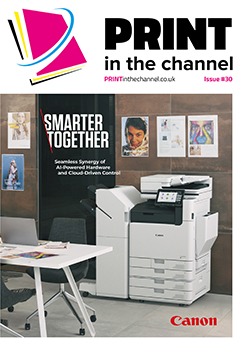Sustainability is a priority for many businesses, and they are looking to all aspects of their operations to find ways to cut the impact on the environment, including printing and the consumables they use – and there are environmental and cost savings to be found.
There is a shift around the world currently, with more businesses waking up to the potential financial and business benefits of moving to a low-emissions future.
The Deloitte 2024 CxO Sustainability Report shows signs of a shift in business climate action with 85% of C-suite executives increasing their sustainability investments in 2024, up from 75% last year.
With this increasing focus on sustainability, every aspect of a business is under scrutiny to find environmental savings, including the printer fleet and the consumables they use.
“Sustainability is increasingly front-of mind for channel partners as they respond to the changing attitudes and expectations of customers,” says Stuart Miller, partner channel director at Canon UK & Ireland.
“Switching to sustainable consumables is one way that businesses can improve their proposition without having to make any major changes to their workflow. At Canon, we work alongside more than 120 partners to deliver sustainable alternatives to customers.”
Debbie Gualtieri, director of product safety & sustainability at Xerox, adds that it is strongly anticipated that global demand for more sustainable cartridges will rise as additional eco-design laws emerge. “Some jurisdictions, such as Italy, are already implementing regulations around the use of sustainable consumables and in these instances, we see a corresponding rise in demand for remanufactured cartridges,” she says.
Greater sustainability
There are many ways in which consumables are becoming more sustainable, with manufacturers taking various approaches to cut the environmental impact of their products.
For instance, Debbie says manufacturers are using reclaimed plastic and post-consumer materials design criteria, conserving the use of new materials. “This is enabled by global collection and recycling processes, with convenient options for customers to return their empty cartridges,” she adds. “Specific Xerox toner cartridges contain as much as 39% reclaimed plastic in new models and, on average, 90% reuse of parts by weight in remanufactured cartridges.”
Stuart adds that to reduce product lifecycle emissions year on year, manufacturers should be focused on making consumables 100% recyclable or reusable and eliminating harmful materials such as single-use plastics from packaging.
“Canon’s ink cartridge recycling programme provides customers with a free and responsible way to recycle empty Canon cartridges,” he says. “Every returned cartridge is reused or recycled, either as a component in a new cartridge, as a base material in other industries, or as a substitute for fossil fuels.”
He adds that a consumable that is often overlooked is printer paper. “But due to the sheer volume being used, a business’s paper choice can have a significant impact on their sustainability performance,” he says.
“Canon has addressed this challenge with our Recycled Zero White paper and Red Label Zero paper, which makes us the first manufacturer to offer carbon neutral paper for wide-format machines. These papers are made from 100% post-consumer waste, are EU Ecolabel certified and are produced carbon-neutrally. To demonstrate the impact that switching to carbon neutral papers can have, plain paper produces 1250kg of CO2 per ton of paper, while the Canon Black Label Zero paper produces only 278kg. That is an emissions reduction of more than 300% and presents businesses with a key opportunity to improve their overall sustainability performance.”
Peter Cowan, group chief operations officer at Data Direct, notes that there are many developments in terms of biodegradable products, and generally higher levels of remanufactured content. “However, many solutions bring a higher cost, and none of the manufacturers are willing to be first to increase costs on the basis of sustainability, so a lot of greenwashing continues,” he says.
“At Data Direct, we have greatly increased the levels of recycled, and recyclable content, especially with waste toner bottles, for example where we range from 100% recycled, to 80% recycled content dependant on availability.”
Toner innovation
Steve Pearce, head of marketing at Kyocera Document Solutions UK, notes that the company takes toner innovation seriously – just like other OEMs. “We do this because toner is designed to work in synergy with print engines to maximise product life and ensure it delivers premium benefits to the end users in terms of imaging quality and reliability,” he says.
To make its toner and toner production more sustainable, Kyocera has made certain developments. “Kyocera’s original toner has a sharp melting core covered by a thin shell that fuses at a temperature 30 degrees lower than that of conventional printers and MFPs, slashing power consumption when printing by half – a hidden cost saving that end-users may not be aware of,” says Steve.
“The standard toner cartridge on the ECOSYS MA4000wifx Series, launched in September, is pretty special – it’s capable of printing 10,000 pages before needing to be replaced. This means less shipping and less plastic waste from spent cartridges. Plus, the toner is Titanium Dioxide free. All benefiting the environment.
“Alongside innovation is the reassurance that our toner is ethically produced in a factory owned by the Kyocera Group – a member of the UN Global Compact with a strong focus on human rights, labour and the environment. Our production plants have targeted ESG goals and prioritise environmental conservation, workplace safety and their co-existence with the local communities.”
Difference it makes
Using sustainable consumables can make an appreciable difference to a business too. “More sustainable consumables are one way to lower the carbon footprint associated with printing, which will help businesses advance toward their sustainability and net zero goals,” says Debbie. “Returning spent consumables for recycling and using consumables with reclaimed and post-consumer materials reduces environmental impacts while supporting brand reputation and stakeholder engagement initiatives.”
Peter adds that sustainability is now a vital part of any major tender for major business/government/education requirements. “In many circumstances, the sustainable credentials rank higher than cost in final evaluation,” he says.
Bringing costs down
It can also help to bring costs down for a business. “Businesses are starting to look to sustainable consumables to make a difference economically, environmentally and socially for their employees,” says Steve. “Businesses will look to long-life consumables that don’t cost the earth, and work to protect device and workplace health.
“Long life components such as Kyocera’s image drums and high-capacity toners are eco-conscious by design. Reducing the frequency of replacement consumables over the lifetime of the product drives down total cost of ownership (TCO) and cuts the need for raw materials, associated emissions and shipping miles.
“Buying cheap can be a false economy. Squeezed margins and procurement budgets must give way to common sense when selecting toner or businesses run the risk of being sold short as quality issues such as light prints, banding or vertical lines surface, compounded by toner dumping and lower stated yields. And then TCO goes up.
“Kyocera’s cartridges are 100% recyclable. They are made from two plastics, contain as few as 10 components and ship in eco-friendly packaging. They are independently tested to output a specific number of pages – the volume expected to maintain low TCO.”
Reseller conversations
When talking to customers about sustainable consumables, there are various facets that should be highlighted.
“Making the switch to sustainable consumables is a change that can have a significant impact on a business,” says Stuart. “Starting, for example, by switching to water-based pigment inks, businesses can reduce their carbon emissions and mitigate the use of harmful chemical substances. Leaders in the market are now offering inks with excellent de-inking properties and zero ozone emissions, so businesses can move towards meeting their sustainability goals.
“Resellers should be discussing these smaller changes that can be made to the workflow, as well as larger initiatives offered by manufactures, such as recycling schemes. Taking this one step further, Canon is working with its partners and customers to develop an all-encompassing low carbon printing strategy that will help them move closer to achieving wider sustainability goals.
“Resellers should discuss the benefits of sustainable consumables, not only from an environmental perspective, but also from a commercial perspective – as more customer tenders are now being upheld by ESG commitments. By working closely with a manufacturer that offers expert advice on sustainability, at every stage of the workflow, resellers can be confident in providing their customers with valuable consultation.”
Peter says that dealers should lead with sustainability as often as possible. “Their customer will soon guide them as to how relevant it is to their business – they may be surprised at the positive feedback they get!”
Debbie adds that resellers should encourage customers to return empty consumable cartridges for recycling and reuse. “Returning spent items diverts materials from landfills and provides a supply of parts and materials for remanufacturing, reducing the demand for new raw materials,” she says. “Customers should also be encouraged to seek options for purchasing remanufactured consumables.”
Provenance
Steve adds that the provenance and performance of consumables should be emphasised by resellers. “You wouldn’t put cheap oil in a sports car as you wouldn’t get the best out of it!” he says.
“Buying cheap alternatives is false economy. Kyocera’s genuine toners for instance provide the quality, low running costs and reliability customers expect from our devices. Resellers could build these arguments into sustainability led sales and marketing initiatives highlighting the energy savings and ecological benefits of sticking to genuine.
“Kyocera partners will emphasise our new UK-based Take Back Toner programme that enables customers to recycle used Kyocera cartridges via a free ‘zero waste to landfill’ collection service where plastics and polymers are turned into recyclate for reuse in the manufacturing of new products.
“In the UK our Carbon Neutral programme extends CO2 offset to consumables of every product in our range. Registering customers receive a certificate of authentication but undermine that climate protection investment if they switch to compatibles.”
Future trends
It is anticipated that manufacturers will continue to improve the sustainability of consumables in the future.
“They have to,” says Peter. “I am sure there are new technologies waiting in the wings which are not yet being marketed. The problem arises where the consumables, which have for so long been the manufacturer’s ‘cash cow’ (to support machine pricing), need to show massive technological development, while keeping running costs low and margins high – a tough formula!”
Debbie adds that manufacturers will continue to design consumables with sustainability in mind, as doing so is good for the environment, corporate social responsibilities and customers’ goals. “Global regulations will continue to drive the development of more sustainable consumables, with eco-design criteria becoming mandatory rather than a nice to have,” she adds. “As customers become more focused on setting and working towards sustainability goals, there will be an increased demand for client-specific analytics on return and recycling rates of consumables sent back for end-of-life processing.”
Steve agrees that sustainable consumables will continue to be developed. “This will take two forms aligned to the reduce, reuse and recycle mantra that addresses the rising demand from consumers to balance affordability – why should anyone pay more for sustainable products?” he says.
“Incremental improvements such as an increase in PCR plastics in product manufacture, and more energy efficient designs will sit alongside advances in technological packaging to reduce material use and shipping emissions.
“Following on from this, I think OEMs will explore how to extend product life, incorporating longer-life image drums and high-yield toners. Perhaps we will see a typical standard rated life extend to 72 months, reducing transportation frequency and lowering running costs.
“Customers will also find that their products and packaging will be far easier to recycle meeting zero waste to landfill goals, and more manufacturers will start to mainstream the recycling of old units into new products on a global basis as they seek to develop strategies that embrace the circular economy.”
Stuart adds that consumers consider not only how sustainable the products are, but also how businesses are managing their wider supply chain. “Manufacturers have a responsibility to drive these conversations forward and help businesses to meet the expectations of consumers,” he says.
“As manufacturers and resellers become more confident in their sustainability offering, the next challenge is to push beyond products, and provide customers with an end-to-end service of sustainability guidance and support.”










